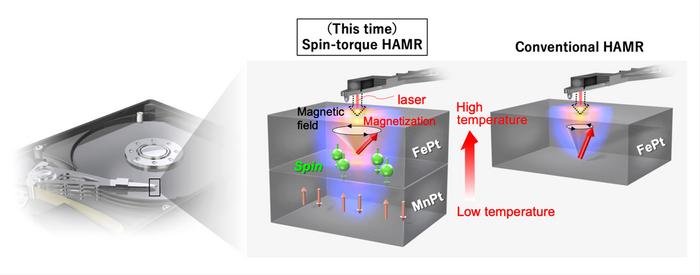
In the ever-evolving landscape of data storage technology, researchers at the National Institute for Materials Science and Seagate Technology have embarked on a groundbreaking investigation into an innovative approach known as Thermal Spin-Torque Heat-Assisted Magnetic Recording (TST-HAMR). This cutting-edge technique promises to revolutionize the future of data writing processes in hard disk drives (HDDs), offering significant improvements in both efficiency and energy consumption.
At the heart of this research lies the traditional methodology employed in heat-assisted magnetic recording (HAMR). In conventional HAMR, a laser is utilized to apply localized heat to the recording medium, a process that facilitates the writing of data. However, this approach has been fraught with limitations. The thermal energy expended in the medium is largely wasted, dissipating without significantly enhancing the recording efficiency. Furthermore, the high temperatures required for effective operation raise concerns regarding potential degradation of the magnetic material over repeated usage cycles.
The research team identified a critical inefficiency in conventional HAMR that could be addressed by rethinking the underlying structural elements of the recording medium. They explored the role of temperature gradients, which are generated during laser irradiation, as a means to enhance recording capabilities. By introducing a novel structure that features an antiferromagnetic manganese-platinum (MnPt) layer positioned beneath the iron-platinum (FePt) recording layer, they have successfully improved recording efficiency by approximately 35%.
The essential breakthrough of this study lies in the spin currents induced by the temperature gradient present within the dual-layer structure. As the laser heats the MnPt layer, it creates a thermal gradient that engenders spin currents represented as green arrows in the accompanying schematic. These currents are funneled into the FePt layer, allowing for the generation of spin torque. This torque plays a crucial role in assisting magnetization reversal, thus facilitating the writing of data with significantly improved efficacy.
Unlike conventional HAMR, which relies solely on thermally induced changes in magnetization, this innovative approach yields a dual mechanism for controlling magnetization: traditional thermal assistance combined with spin torque. This not only elevates the efficiency of the data writing process but also reduces the total thermal energy required, thereby mitigating potential risks to the magnetic and physical integrity of the media.
The implications of the findings from this research extend far beyond the laboratory. The introduction of spin torque as a supporting mechanism for magnetic switching opens up a new realm of possibilities for hard disk drives. In a world increasingly reliant on robust data storage solutions, this advancement could herald the arrival of HDDs that offer both higher capacities and enhanced energy efficiency.
Looking forward, the research team is intent on accelerating the practical application of TST-HAMR technologies. With plans to adapt this approach for use in FePt nanogranular media, they anticipate pushing the boundaries of HDD technology further into new territories of performance and sustainability. The overarching goal is a sophisticated recording method that meets the rising demands for data storage solutions that are not only powerful but also mindful of energy consumption.
The research revolving around TST-HAMR was duly documented and subsequently published in the esteemed journal Acta Materialia on January 13, 2025. This milestone cements the study’s contribution to the scientific discourse surrounding data storage technologies, providing an essential foundation upon which future innovations can be built. As the drive for higher performance and energy-efficient storage systems continues, the findings from this research stand as a testament to the potential advancements achievable through a nuanced understanding of material science and spintronics.
The exploration of this technology highlights a critical intersection where materials science meets practical engineering challenges in the realm of data storage. The researchers’ work does not merely dwell on theoretical frameworks; rather, it manifests in tangible advancements that promise to impact industries reliant on efficient data processing and storage capabilities.
Through their dedication to practical experimental studies, the research team has illuminated pathways for both the design and deployment of next-generation HDDs. The future of data storage technology appears brighter with the implementation of TST-HAMR, raising the bar for what is possible in the storage arena at large. Unquestionably, this marks a significant leap in the quest for more effective and sustainable approaches to data management in our increasingly digital world.
In summary, the pioneering research into TST-HAMR not only challenges existing paradigms but also lays the groundwork for a future where data storage solutions are harmonized with both performance efficiency and environmental considerations. As researchers continue to unlock the complexities of material interactions at the nanoscale, the prospects for innovative technologies that enhance our capabilities in data storage are seemingly limitless.
The narrative woven by this investigation serves as a rallying call for further exploration into material configurations and functionalities in the context of data storage technology. This synthesis of thermal dynamics and spintronics may represent just the beginning of a new era, where the intersections of science and engineering unveil solutions to problems that have long stymied the industry.
As the data storage landscape transforms, the implications of this research will resonate throughout various sectors, underscoring the necessity for continual innovation. In every byte of information written and stored, the impact of TST-HAMR will be felt, forging a path toward a more efficient and robust digital future.
Subject of Research:
Article Title: Thermal spin-torque heat-assisted magnetic recording
News Publication Date: January 13, 2025
Web References:
References:
Image Credits: Shinji Isogami, National Institute for Materials Science; Yichun Fan, Seagate Technology
Keywords
Tags: Advances in HDD TechnologyAntiferromagnetic Materials in HDDdata storage innovationsEnergy Consumption in Data WritingFuture of Data Storage TechnologyHard Disk Drive EfficiencyHeat-Assisted Magnetic Recording LimitationsMagnetic Material DegradationResearch in Magnetic Recording TechniquesSpin-Torque Heat-Assisted Magnetic RecordingTemperature Gradients in Data RecordingThermal Spin-Torque Technology





